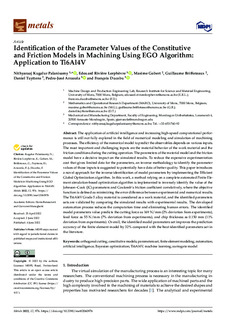| dc.rights.license | Attribution 4.0 International | * |
| dc.contributor.author | ARRAZOLA, PEDRO JOSE | |
| dc.contributor.other | Kugalur-Palanisamy, Nithyaraaj | |
| dc.contributor.other | Rivière-Lorphèvre, Edouard | |
| dc.contributor.other | Gobert, Maxime | |
| dc.contributor.other | Briffoteaux, Guillaume | |
| dc.contributor.other | Tuyttens, Daniel | |
| dc.contributor.other | Ducobu, François | |
| dc.date.accessioned | 2022-07-07T10:41:38Z | |
| dc.date.available | 2022-07-07T10:41:38Z | |
| dc.date.issued | 2022 | |
| dc.identifier.issn | 2075-4701 | en |
| dc.identifier.other | https://katalogoa.mondragon.edu/janium-bin/janium_login_opac.pl?find&ficha_no=168078 | en |
| dc.identifier.uri | https://hdl.handle.net/20.500.11984/5633 | |
| dc.description.abstract | The application of artificial intelligence and increasing high-speed computational performance is still not fully explored in the field of numerical modeling and simulation of machining processes. The efficiency of the numerical model to predict the observables depends on various inputs. The most important and challenging inputs are the material behavior of the work material and the friction conditions during the cutting operation. The parameters of the material model and the friction model have a decisive impact on the simulated results. To reduce the expensive experimentation cost that gives limited data for the parameters, an inverse methodology to identify the parameter values of those inputs is suggested to potentially have data of better quality. This paper introduces a novel approach for the inverse identification of model parameters by implementing the Efficient Global Optimization algorithm. In this work, a method relying on a complete automated Finite Element simulation-based optimization algorithm is implemented to inversely identify the value of the Johnson–Cook (JC) parameters and Coulomb’s friction coefficient correlatively, where the objective function is defined as minimizing the error difference between experimental and numerical results. The Ti6Al4V Grade 5 alloy material is considered as a work material, and the identified parameters sets are validated by comparing the simulated results with experimental results. The developed automation process reduces the computation time and eliminating human errors. The identified model parameters value predicts the cutting force as 169 N/mm (2% deviation from experiments), feed force as 55 N/mm (7% deviation from experiments), and chip thickness as 0.150 mm (11% deviation from experiments). Overall, the identified model parameters set improves the prediction accuracy of the finite element model by 32% compared with the best-identified parameters set in the literature. | en |
| dc.language.iso | eng | en |
| dc.publisher | MDPI | en |
| dc.rights | © 2022 by the authors. Licensee MDPI | en |
| dc.rights.uri | http://creativecommons.org/licenses/by/4.0/ | * |
| dc.subject | Orthogonal cutting | en |
| dc.subject | constitutive models | en |
| dc.subject | parameters set | en |
| dc.subject | Finite element modelling | en |
| dc.subject | Automation | en |
| dc.subject | artificial intelligence | en |
| dc.subject | Bayesian optimization | en |
| dc.subject | Ti6Al4V | en |
| dc.subject | machine learning | en |
| dc.subject | surrogate model | en |
| dc.title | Identification of the Parameter Values of the Constitutive and Friction Models in Machining Using EGO Algorithm: Application to Ti6Al4V | en |
| dcterms.accessRights | http://purl.org/coar/access_right/c_abf2 | en |
| dcterms.source | Metals | en |
| local.contributor.group | Mecanizado de alto rendimiento | es |
| local.description.peerreviewed | true | en |
| local.identifier.doi | https://doi.org/10.3390/met12060976 | en |
| local.contributor.otherinstitution | https://ror.org/02qnnz951 | es |
| local.source.details | Vol. 12. N. 6. N. artículo 976, 2022 | en |
| oaire.format.mimetype | application/pdf | |
| oaire.file | $DSPACE\assetstore | |
| oaire.resourceType | http://purl.org/coar/resource_type/c_6501 | en |
| oaire.version | http://purl.org/coar/version/c_970fb48d4fbd8a85 | en |








